Ecuatoriana de Aviación
 | |||||||
| |||||||
| Founded | May 1957 (as Compañía Ecuatoriana de Aviación) | ||||||
|---|---|---|---|---|---|---|---|
| Commenced operations | August 1957 | ||||||
| Ceased operations | 2006 | ||||||
| Hubs | Mariscal Sucre International Airport | ||||||
| Focus cities | Simón Bolívar International Airport | ||||||
| Frequent-flyer program | Lider Club | ||||||
| Destinations | 30 | ||||||
| Parent company | VASP (50.1%) | ||||||
| Headquarters | Quito, Ecuador | ||||||
Empresa Ecuatoriana de Aviación, more commonly known as simply Ecuatoriana, was the national airline of Ecuador.[1] The carrier had an operational hiatus in September 1993,[1] but was reactivated in August 1995, resuming operations on 23 June 1996, after VASP became the controlling shareholder. The airline folded permanently in 2006.
History
Compañía Ecuatoriana de Aviación
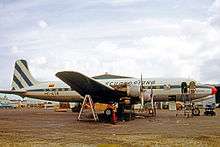
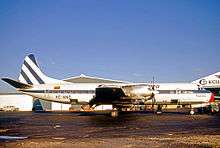
Compañia Ecuatoriana de Aviación (CEA) (English: Ecuadorian Aviation Company) was established in May 1957,[2] after a group of American and Ecuadorian investors decided to set up an airline. At first, 50 percent of the airline was owned by Americans. Operations started in August 1957.[2] Serving a relatively small country, the airline had a varied fleet that consisted of Curtiss C-46, Douglas DC-4, Douglas DC-6 and one Junkers K 16 aircraft. The Junkers airplane was a rarity, as Junkers airliners were already considered to be classics at the time.
Ecuatoriana began serving both domestic and international destinations immediately after they started flying. International routes proved to be rather long trips: there were jets already in operation when Ecuatoriana began flying (before the Boeing 707 made its first flight), but they were predominantly used by European airlines. Ecuatoriana's equipment necessitated a stopover in Panama City for their first international route, from Quito to Miami. Likewise, routes from Quito and Guayaquil to Santiago de Chile included stopovers in Lima, Peru.
The airline's livery featured a tailfin logo of alternating blue and white diagonal stripes. The airline operated Lockheed L-188 Electra four-engined turboprop airliners on longer distance scheduled passenger services, including the key Quito-Bogota-Miami route, between March 1967 and March 1975.[3]
Empresa Ecuatoriana de Aviación
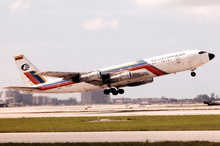
American investors pulled out of the company during the early 1970s, prompting the creation of a new company. Empresa Ecuatoriana de Aviación, a state-owned company, took over the routes, liabilities, and assets of CEA. It was established in July 1974, becoming the flag carrier of Ecuador.[4][5] By this time, the airline had modernized their fleet to include the Boeing 707, and a new, colorful "rainbow" livery attracted airplane spotters at new destinations such as New York's John F. Kennedy International Airport and Buenos Aires' Ezeiza International Airport. Some of Ecuatoriana's aircraft became flying canvases for abstract artwork. These distinctively-painted aircraft were seen as a response to Braniff's Alexander Calder-painted aircraft. During the late 1970s and early 1980s, Braniff was Ecuatoriana's main competitor on many routes, including Miami-Quito/Guayaquil.
In the 1970s, most South American national airlines were operated by national air forces. Through the Defence Ministry, the Ecuadorian Air Force bought two refurbished Boeing 707s for the airline from Israeli Aircraft Industries in a deal worth US$4,700,000 (equivalent to $23,322,402 in 2017) million.[6] Ecuatoriana also acquired a Douglas DC-10 from Swissair, and they opened non-stop routes to Canada. Having jet equipment meant that long flights with stopovers were no longer necessary, and non-stop routes were opened all over South America and to other North American cities.
Ecuatoriana also opened flights to destinations such as Mexico City and Madrid, Spain. The Quito and Guayaquil to Madrid routes in particular proved extremely competitive, as Iberia was popular among travelers who flew those two routes.
During the 1980s, Ecuatoriana de Aviación began conducting business with the European Airbus consortium, buying Airbus A310 jetliners. Ecuatoriana debuted a pair of Airbus A-310s in the early 1990s.
Collapse
Rumors that government officials flew their family members for free on Ecuatoriana hurt the airline's reputation. During the late 1980s, Ecuatoriana had also developed a reputation for being unreliable. Lengthy flight delays and cancellations were commonplace. Faced with these problems, as well as competition from other carriers such as the privately owned Ecuadorian carrier SAETA, American Airlines (which had assumed Eastern Air Lines' Latin America routes in 1990), and Continental Airlines, which began serving Ecuador from its Houston hub in 1991, Ecuatoriana ceased operations.
Affected by the general economic crisis in South America during the 1990s, Ecuatoriana encountered deep financial problems. The airline stopped flying at the end of September 1993 as some of their leased airplanes, (two A-310s leased directly from Airbus and their single DC-10 were taken back and the latter stranded in Panama) since Ecuatoriana was not able to meet the lease payments. Ecuatoriana was forced to rely on competitors TAME and SAETA to fly its North and South American routes, after a deal with Costa Rican LACSA broke down.[7] At the end of 1994, SAETA made a $31 million bid in an attempt to acquire Ecuatoriana, but this didn't go through.[8]
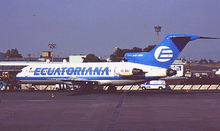
After a lengthy privatization process, with the participation of nine consortiums that included ACES, Air France, British Aerospace, Carnival Airlines, Challenge Air Cargo, Continental Airlines, Aerogal and TACA, the consortium led by Brazilian airline VASP (and local investor Juan Eljuri) won the bid through the Guayaquil and Quito stock exchanges, buying 50.1 percent of it in August 1995 (at $1500 per stock), with a five-year business plan and an effective injection of $10 million during the stock bidding. The government retained the remaining 49.9% and announced it would keep 25% of the remaining stocks (administered by TAME), with 24.9% to be sold within six months. The process was not exempt from political controversy, as the Comptroller, the Supreme Court and the Congress all questioned the process.[9]
With privatization complete, Ecuatoriana received some Boeing 727s, which were repainted in Miami and at Tucson International Airport in Tucson, Arizona. By 1996, short domestic and international services were restarted, with a livery that resembled VASP's. A single DC-10, also borrowed from VASP, allowed the airline to reintroduce services to Madrid's Barajas International Airport.
March 2000 saw the airline flying to Buenos Aires, Cancún, Guayaquil, Manaus, Mexico City, Panama City and Santiago using one Airbus A310-300, three Boeing 727-200 Advanced and one McDonnell Douglas DC-10-30.[10] That year, Ecuatoriana was caught up in an overall collapse of Ecuador's economy and once again found itself in financial trouble, and VASP decided to sell its part of the airline, with both Aero Continente and Lan Chile being bidders at that time.[11] Despite claims that Lan Chile was not interested in Ecuatoriana, the Chilean carrier was operating its own aircraft on behalf of Ecuatoriana on the lucrative routes to the USA after Ecuatoriana's aircraft were repossessed by lessors in late 2000.[12] Following the rejection of Aero Continente's bid and the suspension of Ecuatoriana's air operator certificate, Ecuador's civil aviation authority cleared Lan Chile to start up a subsidiary named Lan Ecuador to fly many international routes previously operated by Ecuatoriana.[13][14]
Lan Chile owned fifty percent of the airline, wet-leasing two Boeing 767's to the company, but in 2004 they sold their part to Lloyd Aéreo Boliviano. By early 2005 LAN had taken over their routes and fleet.
Destinations
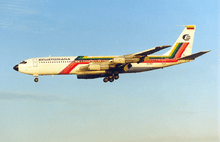
Ecuatoriana served the following destinations throughout its history:
Historical Fleets
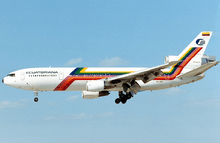
The airline operated the following equipment at various times during its history:
Accidents and incidents
- On 14 March 1972, Douglas C-47 HC-SJE was reported to have been damaged beyond economic repair in an accident at Sangay.[20]
References
- 1 2 "Ecuador joins privatisation queue". Flight International: 17. 23–29 November 1994. Archived from the original on 20 March 2013.
- 1 2 "World Airline Direcrtory–Compania Ecuatoriana de Aviacion (CEA)". Flight International. 21 March 1974. Archived from the original on 20 March 2013.
- ↑ Sherlock, 1977 p. 16
- ↑ "World airline directory–Alphabetical guide to operators—Ecuatoriana (Empresa Ecuatoriana de Aviacion)". Flight International: 1370. 28 April 1979. Archived from the original on 5 October 2012.
- ↑ "Air Transport–Compañía Ecuatoriana de Aviación (CEA)". Flight International: 514. 17 October 1974. Archived from the original on 20 March 2013.
Compania Ecuatoriana de Aviacion (CEA) has been absorbed into the new national airline of Ecuador, Empresa Ecuatoriana de Aviacion. Operations are expected to begin shortly.
- 1 2 "Airliner Market". Flight International: 744. 28 November 1974. Archived from the original on 21 March 2013.
Ecuatoriana is to take delivery of two refurbished Boeing 720Bs from Israeli Aircraft Industries. The aircraft were bought for the airline by the Defence Ministry for $4.7 million and are painted in a livery similar to that on Braniff's "Calder DC-8".
- ↑ http://www.eltiempo.com/archivo/documento/MAM-232885
- ↑ http://www.eltiempo.com/archivo/documento/MAM-262516
- ↑ http://www.eltiempo.com/archivo/documento/MAM-386630
- ↑ "World airline directory – Ecuatoriana de Aviacion". Flight International. 157 (4720): 81. 21 March 2000 – 27 March 2000. ISSN 0015-3710. Archived from the original on 12 February 2014. Check date values in:
|date=(help) - ↑ Flores, Jackson (21 May 2002). "Aero Continente set to buy Ecuadorian carrier". Flightglobal.com. Rio de Janeiro. Flight International. Archived from the original on 25 June 2012. Retrieved 25 June 2012.
Aero Continente has been competing with Chilean flag carrier LanChile to acquire the carrier from Ecuatoriana's owners, the Ecuadorian government (49.9%) and Brazilian airline VASP (50.1%). Aero Continente wants to acquire 69.95% of Ecuatoriana's stock.
- ↑ "AeroContinente seeks stronger role". Flightglobal.com. Airline Business. 1 June 2002. Archived from the original on 25 June 2012. Retrieved 25 June 2012.
- ↑ Flores, Jackson (13 August 2002). "Start-up LanEcuador gets all-clear". Flightglobal.com. Rio de Janeiro. Flight International. Archived from the original on 25 June 2012. Retrieved 25 June 2012.
- ↑ "No to AeroContinente bid". Flightglobal.com. Airline Business. 1 July 2002. Archived from the original on 25 June 2012. Retrieved 25 June 2012.
- 1 2 3 4 5 6 7 8 9 10 11 12 13 14 "World Airline Directory–Ecuatoriana" (PDF). Flight International: 68. 25 March 1998–31 March 1998. Retrieved 24 October 2011. Check date values in:
|date=(help) - 1 2 3 "Ecuatoriana Timetable (Effective 1 July 1980)–Miami/Nassau/South America, New York/Panama/South America". Airline Timetable Images. Archived from the original on 25 June 2012. Retrieved 25 June 2012.
- 1 2 3 "Ecuatoriana Timetable (Effective 1 July 1980)–Los Angeles/Mexico/South America, Within South America". Airline Timetable Images. Archived from the original on 25 June 2012. Retrieved 25 June 2012.
- 1 2 3 4 "World Airline Directory–Ecuatoriana (Empresa Ecuatoriana de Aviacion)" (PDF). Flight International: 88. 24 March 1993–30 March 1993. Retrieved 6 December 2011. Check date values in:
|date=(help) - 1 2 3 "World Airline Directory–Empresa Ecuatoriana de Aviacion SA" (PDF). Flight International: 485. 1975-3-230. Retrieved 28 October 2011. Check date values in:
|date=(help) - ↑ "HC-SJE Accident description". Aviation Safety Network. Retrieved 5 September 2010.
Bibliography
- Sherlock, Jay L., Lockheed L-188 Electra and Orion, Air-Britain (Historians) Ltd, 1977, ISBN 0-85130-058-8
External links
| Wikimedia Commons has media related to Ecuatoriana. |